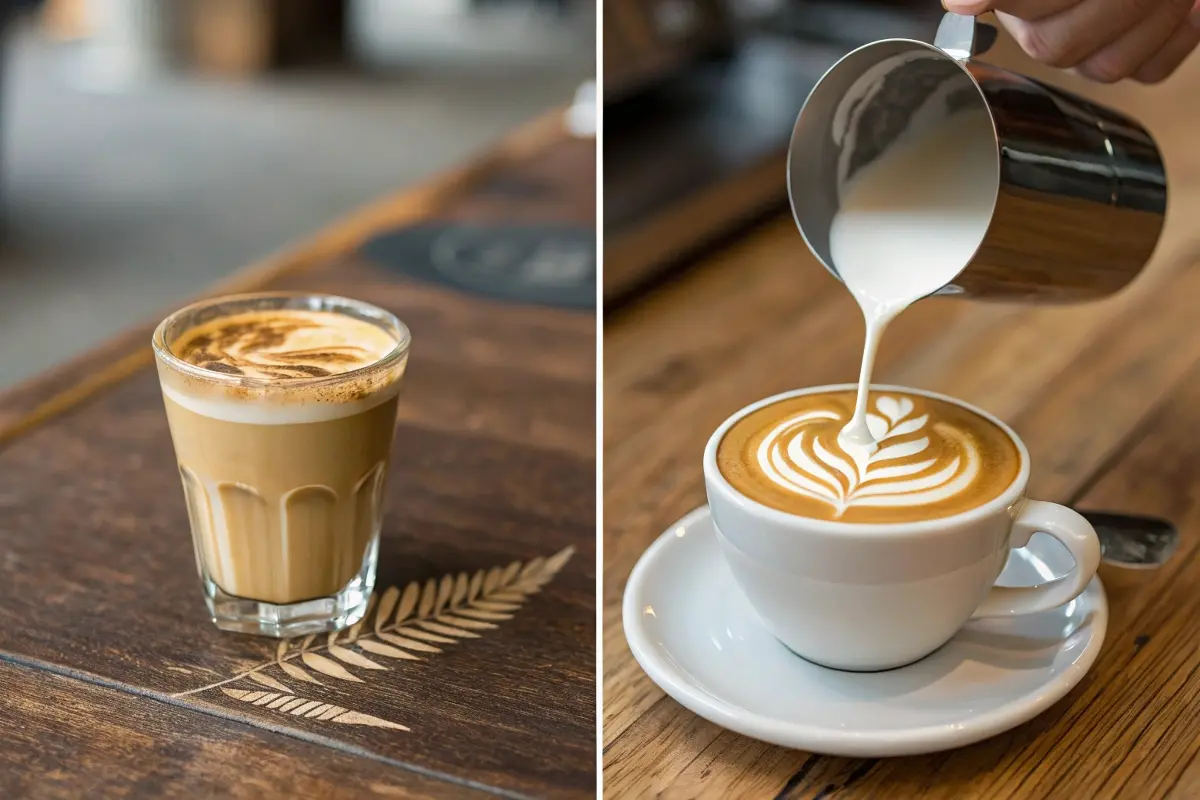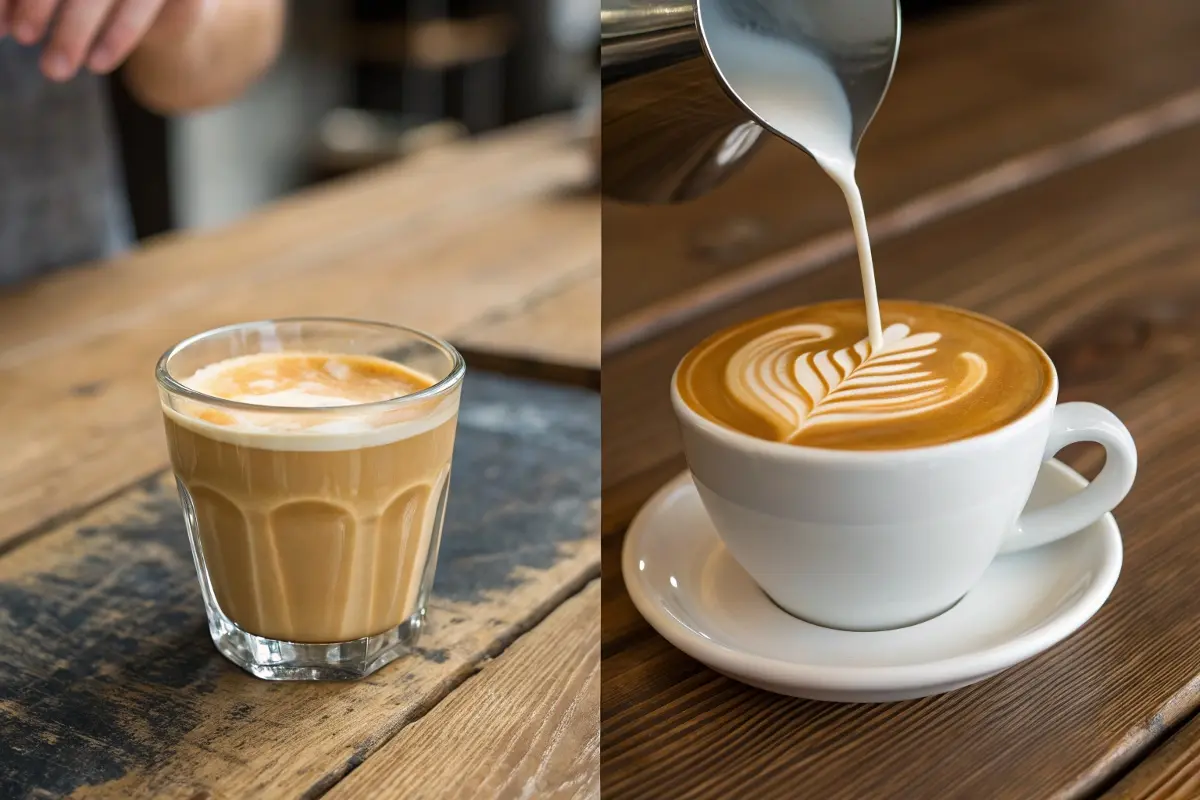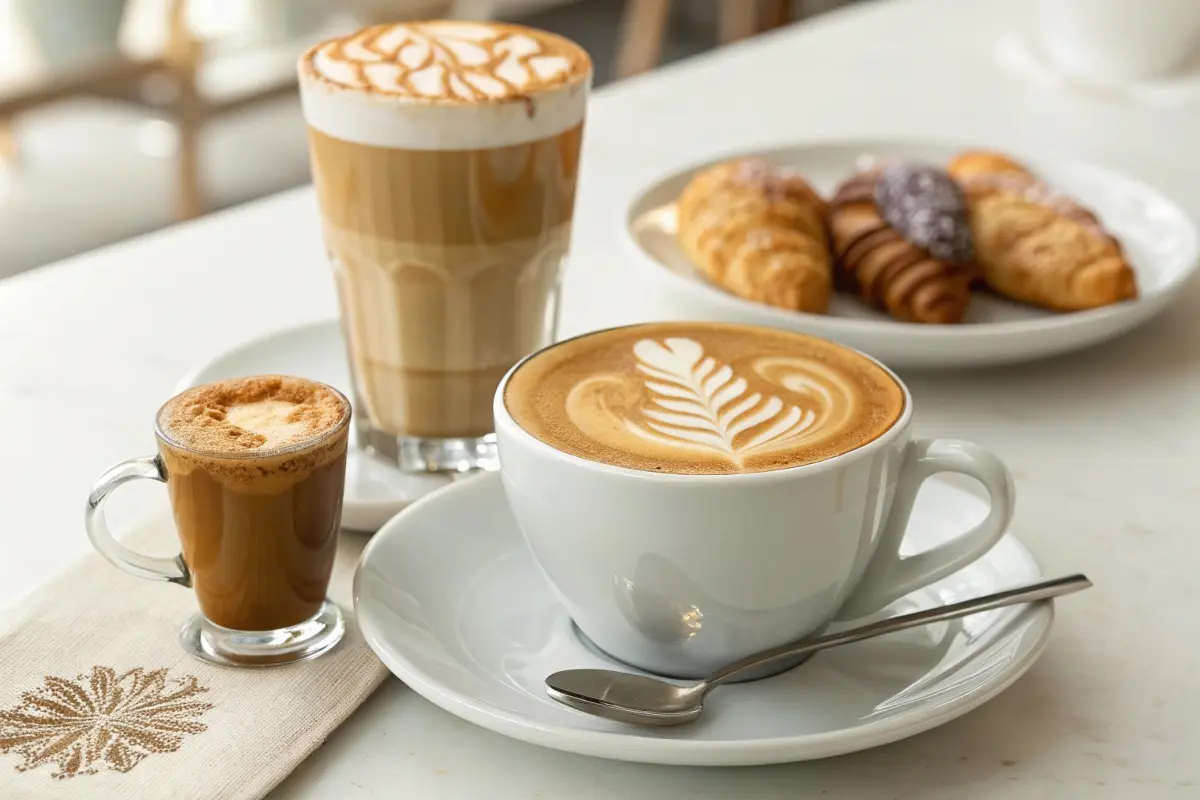If you’ve ever stood in line at your favorite coffee shop, staring at the menu and wondering what makes a cortado different from a latte, you’re not alone. Both drinks are beloved by coffee enthusiasts, yet they offer unique experiences. So, what’s the real difference? Let’s dive into the details to clear up the confusion!

An Overview of Latte and Cortado
Before we break things down, let’s look at the basics. Both latte and cortado are espresso-based drinks that include milk. The magic lies in how they’re prepared, the milk-to-espresso ratio, and their cultural significance.
A latte is known for its creamy texture, often topped with beautiful latte art. Meanwhile, a cortado offers a bolder espresso flavor, thanks to its balanced milk-to-espresso ratio.
The Origins of the Latte
The latte, also known as a “caffè latte,” comes from Italy. In Italian, it simply means “milk coffee.” Traditionally, it’s enjoyed as a breakfast drink in Italy, paired with a pastry or biscotti. Over time, it evolved into the frothy, artistic beverage we now associate with third-wave coffee culture.
The Origins of the Cortado
The cortado hails from Spain, where it’s a staple in local cafés. The name “cortado” comes from the Spanish word cortar, meaning “to cut.” It refers to the milk cutting through the sharpness of espresso. This drink is traditionally served in a small glass, making it a no-frills, quick pick-me-up.
“A cortado is like the espresso’s sophisticated cousin—sharp, bold, and straight to the point.”
Key Ingredients of a Latte
The latte’s ingredients are simple: espresso, steamed milk, and a layer of microfoam. However, it’s how these ingredients are combined that creates its signature taste.
Espresso in a Latte
Espresso is the base of every latte. It’s usually made with one or two shots, offering a rich and robust flavor.
Milk and Foam Composition in a Latte
A latte contains a higher proportion of steamed milk compared to espresso. The milk is steamed to create a velvety texture, while the microfoam adds an airy finish.
Key Ingredients of a Cortado
The cortado, on the other hand, is simpler in its execution. It focuses on balancing espresso and milk equally.
The Role of Espresso in a Cortado
Like the latte, a cortado starts with a shot or two of espresso. Its flavor, however, remains bold because it isn’t diluted by excess milk.
How Milk Balances the Cortado
In a cortado, the milk is steamed but not frothed, resulting in a smooth consistency that mellows the espresso without overwhelming it.
Latte vs. Cortado: Preparation Techniques
Brewing the Perfect Latte
To make a latte:
- Brew one or two shots of espresso.
- Steam milk to around 140°F–150°F (not boiling).
- Pour the steamed milk over the espresso, finishing with a thin layer of foam.
For a bit of artistry, you can practice creating heart or rosette patterns on the foam. Latte art isn’t just for looks—it’s part of the experience!
Crafting a Traditional Cortado
Preparing a
simpler but equally rewarding. Here’s how:
- Start with a shot or two of espresso, brewed to perfection.
- Steam milk until it’s warm, not frothy, to create a smooth texture.
- Add an equal amount of steamed milk to the espresso.
Unlike a latte, there’s no foam or art involved; the focus is entirely on the flavor. Cortados are often served in small, clear glasses, highlighting their rich simplicity.

Flavor Profiles: Latte vs. Cortado
When it comes to flavor, lattes and cortados couldn’t be more different. Each drink has its own personality, catering to different preferences.
The Smooth Creaminess of a Latte
A latte is creamy, mild, and comforting. Thanks to the larger amount of milk, the espresso flavor takes a backseat, making it a great option for those who prefer a softer coffee experience.
The Bold Simplicity of a Cortado
In contrast, the cortado is bold and direct. With an equal espresso-to-milk ratio, the espresso’s robust flavor shines through, only slightly mellowed by the milk. It’s perfect for those who love their coffee strong but not overly bitter.
“If a latte is a warm hug, a cortado is a firm handshake—straightforward and full of character.”
Caffeine Content: Latte vs. Cortado
The caffeine levels in a latte and a cortado vary depending on their size and preparation.
Why Lattes Are Preferred for a Milder Boost
Lattes typically contain more milk, which can make them feel less intense even if they have the same amount of espresso as a cortado. This makes them ideal for a slower-paced morning.
Cortado’s Intense Caffeine Punch
A cortado’s smaller size and concentrated espresso flavor often give the impression of a stronger caffeine hit, even though the actual caffeine content may be similar to that of a latte.
Common Serving Styles Around the World
Latte Art: Creativity in a Cup
Lattes are famous for their artistic presentations. From hearts to intricate designs, latte art has become a hallmark of modern coffee culture. It’s as much about the visual appeal as the taste.
Cortado Glassware and Presentation
The cortado keeps things simple, traditionally served in a small, clear glass to emphasize its minimalism. Some variations, like the Gibraltar, take inspiration from this approach but are served in a slightly larger glass.
Nutritional Differences Between a Latte and a Cortado
Let’s break it down with a simple table:
| Drink | Calories | Fat | Protein | Caffeine |
|---|---|---|---|---|
| Latte (8 oz) | ~120 | 5g | 6g | ~75-100 mg |
| Cortado (4 oz) | ~50 | 2g | 2g | ~75-100 mg |
As you can see, a cortado is a leaner choice, while a latte provides a more indulgent experience.
Recipe: How to Make a Latte and a Cortado at Home
Ingredients for a Latte
- 1–2 shots of espresso
- 6 oz steamed milk
- Microfoam (optional for art)
Preparation:
- Brew the espresso and pour it into a large cup.
- Steam the milk until it’s warm and frothy.
- Pour the steamed milk over the espresso, holding back the foam with a spoon.
- Add the foam on top if desired, and create latte art if you’re feeling fancy.
Ingredients for a Cortado
- 1–2 shots of espresso
- 2 oz steamed milk
Preparation:
- Brew your espresso and pour it into a small glass.
- Steam the milk until it’s smooth and warm, but without froth.
- Add the steamed milk to the espresso, maintaining a 1:1 ratio.
Cultural Significance of Lattes and Cortados
The Latte as a Symbol of Modern Coffee Culture
Lattes have become synonymous with café culture worldwide. From trendy coffee houses in New York to bustling spots in Tokyo, the latte is a drink that transcends borders, often customized with flavors like vanilla, caramel, or pumpkin spice.
Cortado’s Roots in Traditional Cafes
On the flip side, the cortado remains a favorite in Spain and Latin America. It’s a no-nonsense drink that reflects a more traditional approach to coffee—simple, straightforward, and unpretentious.
When to Choose a Latte vs. a Cortado
Latte for a Leisurely Sip
If you’re in the mood to relax with a larger, creamier drink, a latte is your go-to. It pairs well with reading a book or catching up with friends.
Cortado for a Quick, Flavorful Boost
Need a quick caffeine hit without the fuss? The cortado’s smaller size and intense flavor make it a perfect choice for those on the go.
Common Misconceptions About Lattes and Cortados
While both drinks are well-known, they’re often misunderstood. Here are a few myths and truths to set the record straight.
Misunderstanding Milk Ratios
A common misconception is that a latte and a cortado have the same amount of milk. In reality, a latte uses much more milk, which creates its larger volume and creamier texture. The cortado sticks to an equal milk-to-espresso ratio, keeping it more compact and focused.
The Confusion with Other Espresso-Based Drinks
People often mix up cortados with drinks like macchiatos or flat whites. While they may seem similar, each has a distinct milk-to-espresso ratio and preparation method. A cortado balances milk and espresso equally, while a macchiato is mostly espresso with just a touch of milk.
“Think of the cortado as the Goldilocks of espresso drinks—not too milky, not too strong, but just right.”
How to Master Latte and Cortado Preparation at Home
Brewing café-quality lattes and cortados at home isn’t as intimidating as it sounds. With the right tools and techniques, you can elevate your home coffee game.
Choosing the Right Espresso Beans
The foundation of any great latte or cortado is high-quality espresso beans. Look for medium to dark roasts for a rich, balanced flavor. Grinding the beans fresh before brewing also makes a huge difference.
Perfecting Milk Frothing Techniques
For a latte, aim to create velvety microfoam by steaming milk to around 140°F–150°F. For a cortado, focus on steaming the milk without froth, ensuring it blends smoothly with the espresso.
Tips for Cortado’s Espresso-to-Milk Balance
To nail the 1:1 ratio, measure your espresso shot and milk carefully. Use a clear glass to see the layers as you pour—this visual guide ensures you’re maintaining balance.
Exploring Variations of Lattes and Cortados
Every coffee drink has its twists, and lattes and cortados are no exception. Here are a few exciting variations to try.
Vanilla and Mocha Lattes
Lattes are a canvas for creativity. Add syrups like vanilla, caramel, or hazelnut for a touch of sweetness. Or, turn your latte into a dessert-like treat with a pump of chocolate syrup to create a mocha latte.
Cortado Variations Like Gibraltar and Flat White
The Gibraltar is essentially a cortado served in a small glass tumbler, popularized by San Francisco’s coffee scene. A flat white, often compared to a cortado, has a slightly different milk texture, offering a creamier finish.
“Variations keep coffee interesting, like different instruments in a symphony—they each add a unique note.”
Recommendations for Coffee Enthusiasts
Whether you’re a latte lover, a cortado enthusiast, or both, these tips and resources will enhance your coffee experience.
Best Cafes to Try Lattes and Cortados
Visit specialty coffee shops to taste expertly crafted versions of both drinks. Seek out places known for their skilled baristas and high-quality beans.
Equipment to Enhance Home Brewing
Investing in the right tools makes a world of difference. A reliable espresso machine, milk frother, and a quality grinder are essential for replicating the café experience at home.
FAQs
Is a cortado the same as a flat white?
Not quite! While both drinks involve espresso and milk, they differ in ratios and textures. A cortado uses an equal ratio of espresso to milk (1:1), resulting in a small, balanced drink with no foam. A flat white, on the other hand, has a higher milk-to-espresso ratio and features velvety microfoam, giving it a creamier texture similar to a latte but smaller in size.
What is a cortado vs. macchiato?
A cortado and a macchiato are distinct in preparation and taste. A cortado balances espresso and steamed milk equally, creating a smooth and mild drink. A macchiato, however, is primarily espresso “marked” with just a dollop of foamed milk, making it stronger and more intense in flavor compared to a cortado.
Is cortado strong?
Yes, a cortado is considered strong in terms of flavor, but it’s not overpowering. The equal ratio of espresso to milk ensures that the boldness of the espresso shines through, while the milk softens its intensity without masking the taste. It’s the perfect choice for those who enjoy robust coffee flavors in a smaller, balanced serving.
Latte and Cortado – Two Sides of the Espresso Spectrum
Ultimately, the latte and cortado are two distinct expressions of the espresso art form. A latte invites you to linger with its creamy comfort, while a cortado offers a quick, bold burst of energy. Whether you’re in the mood for a relaxing sip or a no-nonsense coffee experience, both drinks have something special to offer.
So, next time you’re at a café or brewing at home, consider what you’re craving—a warm, indulgent latte or a straightforward, flavorful cortado. Whatever you choose, you can’t go wrong.
“Coffee isn’t just a drink; it’s a story in a cup, waiting to be savored.”

